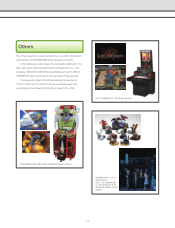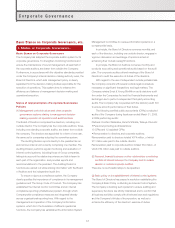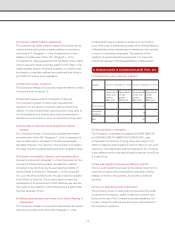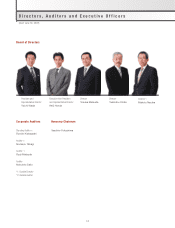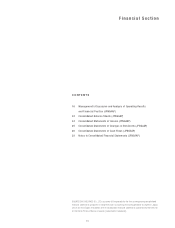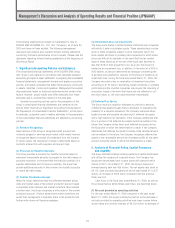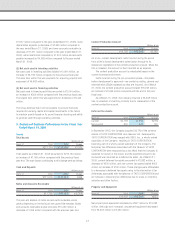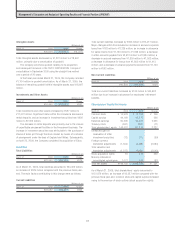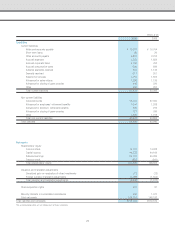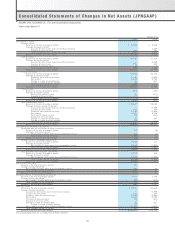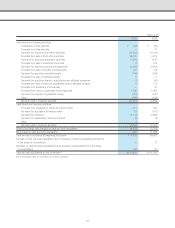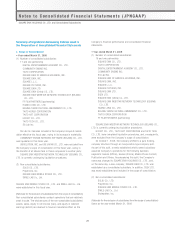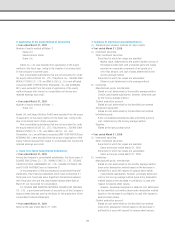Square Enix 2009 Annual Report Download - page 22
Download and view the complete annual report
Please find page 22 of the 2009 Square Enix annual report below. You can navigate through the pages in the report by either clicking on the pages listed below, or by using the keyword search tool below to find specific information within the annual report.
Asia
Millions of yen
Years ended March 31 2008 2009 Change
¥1,118 ¥1,298 ¥180
In Asia, the Group primarily is engaged in the Games (Online) and
Amusement businesses. In the Games (Online) business, the Group
primarily operates online game services for the PC platform in
China. In the Amusement business, the Group operates game
arcade facilities in South Korea and China.
Sales in Asia in the fiscal year ended March 31, 2009 increased
by ¥180 million to ¥1,298 million.
Millions of yen Yen
Date of resolution Total dividends Dividends per share
November 7, 2008
Resolution of the Board of Directors ¥1,149 ¥10
June 24, 2009
Resolution of the Annual General
Meeting of Shareholders 2,300 20
6. Risk Factors
The risks described below are those that could affect the Company’s
business performance. Forward-looking statements in this manage-
ment discussion and analysis are in accordance with management’s
judgments as of June 30, 2009.
(1) Changes in the Economic Environment
In the event of an exceptionally harsh downturn in the economy
causing consumer expenditure to fall, demand for the Group’s
products and services in the entertainment field may decline. Such
circumstances may lead to an adverse impact on the Group’s
business performance.
Management’s Discussion and Analysis of Operating Results and Financial Position (JPNGAAP)
The Group’s operating targets for the fiscal year ending March 31, 2010 are as follows (as of May 19, 2009).
Millions of yen
Years ended/ending March 31 2004 results 2005 results 2006 results 2007 results 2008 results 2009 results 2010 targets
Net sales ¥63,202 ¥73,864 ¥124,473 ¥163,472 ¥147,516 ¥135,693 ¥180,000
Operating income 19,398 26,438 15,470 25,916 21,520 12,277 25,000
Recurring income 18,248 25,901 15,547 26,241 18,864 11,261 25,000
Net income 10,993 14,932 17,076 11,619 9,196 6,333 15,000
5. Dividend Policy
The Group recognizes the return of profits to shareholders as one
of its most important management tasks. The Company maintains
internal reserves to enable priority to be given to investments that
will enhance the value of the Group. Such investments may include
capital investments and M&A for the purpose of expanding existing
businesses and developing new businesses. The retention of
internal reserves is done while also taking into account return to
shareholders, operating performance and the optimal balance for
stable dividends. Accordingly, the Company strives to maintain
stable and continuous dividends. The portion of dividends linked to
operating results is determined by setting a consolidated payout
ratio target of approximately 30%.
The Company’s basic policy is to pay dividends from retained
earnings twice a year, through an interim dividend and a year-end
dividend.
For the fiscal year ended March 31, 2009, total dividends
applicable to the year were ¥30 per share, comprising an interim
dividend of ¥10 per share and a year-end dividend of ¥20 per
share. The consolidated payout ratio for the fiscal year ended
March 31, 2008 was 54.4%.
4. Strategic Outlook, Issues Facing Management and
Future Direction
Management’s key task is to ensure growth in the Group in the
medium- and long-term, maintaining profitability through the
creation of advanced, high-quality content and services. As the
development and popularization of information technology (IT) and
network environments rapidly advance, we anticipate a major
transformation in the structure of the digital entertainment industry.
We believe that this will be driven by such factors as increased
consumer needs in the area of network-compliant entertainment
and growing access to a diverse range of content by users of
devices that provide multiple functions.
The Group will strive to respond to these changes, and has
adopted a medium- to long-term management strategy that focuses
on pioneering a new era in digital entertainment.
20



